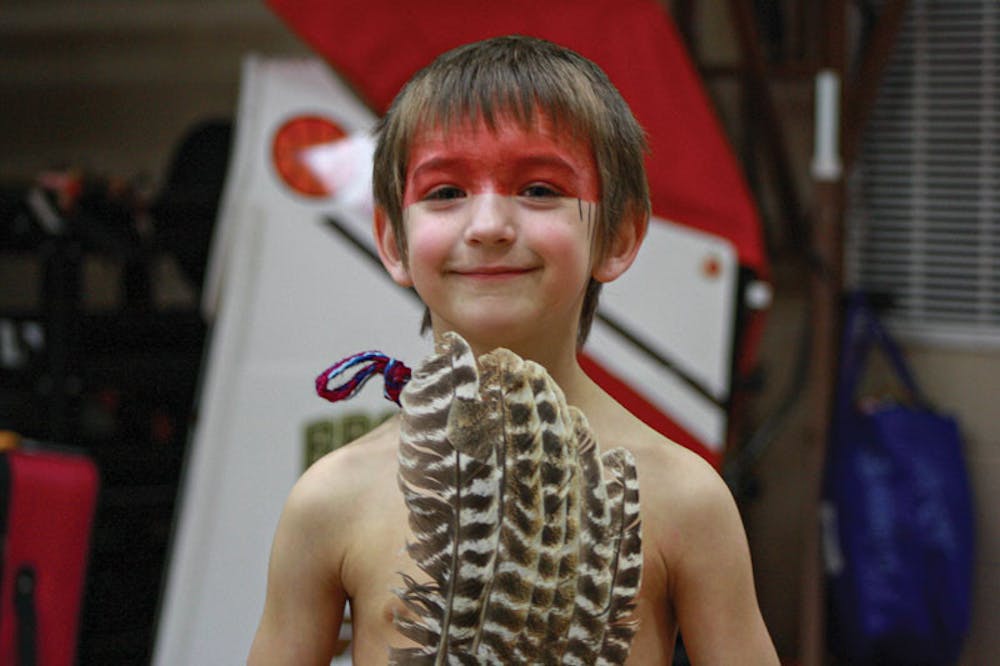Brown’s Native American Heritage Series and Native Americans at Brown hosted the 13th annual Spring Thaw Powwow for students and local Native American communities Sunday. Offering dance competitions, drumming, native food vendors and arts and crafts, the powwow attracted members from various tribes and kicked off the start of the Northeast’s powwow season. It will be followed by events at the University of Massachusetts at Amherst and Harvard.
“We have people coming up from upstate New York and a group bringing a drum down from Nova Scotia,” said Niyo Moraza-Keeswood ’16, one of the co-organizers of the powwow. “There’s a real close-knit community on the powwow trail.” People from around the Northeast greeted each other as old friends, demonstrating this closeness.
After each of the 14 dance competitions, the competitors shook hands and congratulated each other on their performances. “We teach these youngsters how to act at a young age,” said the announcer of the dance competition. As the Mystic River drum group played, head dancers Quahna Mars and Atsa Zah continued the sense of unity, inviting many spectators to join them for larger dances.
The powwow “is a way of life,” said Domingo Talldog, a craft vendor from the Narragansett tribe who has come to the event every year. “You see friends here who you haven’t seen since last year. It really is a ‘spring thaw’ after the winter, like everyone’s thawing out as they return to this special community.”
“We try to go to as many powwows from the border of Canada to Florida,” said Talldog’s sister, Darlene Monroe.
Talldog was one of several craft and wampum vendors at the powwow, selling walking sticks, jewelry, t-shirts, belts and dance regalia. And while many people wore their street clothes, much of the crowd wore traditional Native American outfits.
“The powwows are the same thing as Sunday mass for me; there’s that same spirituality, tradition and communion that you’d have at church,” said Nancy Spiritbire from both the Abenaki and the Mohican tribes, dressed in a buckskin dress with two pelts draped across her shoulders.
This culture of inclusivity and spirituality at the powwow relies on a combination of different traditions, said Elizabeth Hoover MA’03 PhD’10, assistant professor of American and ethnic studies.
The “powwow” originates from the Algonquin word for a medicine person. It eventually became used to describe the large crowds and rituals surrounding the healing process, Hoover said, adding that in response to the 19th-century banning of Indian religion, tribes of the Western Plains used powwows as a more general means of spirituality and celebration. The powwow created an opportunity to bring the public onto the reservation, while maintaining traditions and family connections that would have otherwise been lost. As these celebrations spread, many tribes added to the traditions of the powwow.
At the Spring Thaw Powwow, for example, people performed the Grass Dance from the plains, the Jingle Dance from around the Great Lakes and the Eastern War Dance from the Northeast. For Hoover, who helped introduce the Powwow to Brown in 2002, this gathering has a spirit and identity of its own created by the union of multiple Native American cultures, she said.
While the local Native American community remains heavily involved and active in the Spring Thaw Powwow, the student group NAB hopes to increase the student population at the event. “The hardest part is advertising to the general Brown community,” said Nate Harris ’15, another co-organizer of the event. “We’re really excited to put on the powwow after working on it since November, but we’d like to raise participation for students.”
“The powwow should help the Brown community as a way to interact with Native culture,” Moraza-Keeswood said.“There’s a general lack of acknowledgment and understanding of a culture that is still very much alive and thriving. Once you’re in the circle of the powwow, it’s a sacred place bringing people together, and ideally it would allow Brown students to experience the Native cultural experience.”
The movement for broader awareness of the Native culture on campus first came about in the 1980s with the inception of NAB. Currently, Native American history and culture is taught as a possible focus of the ethnic studies concentration in the American studies department, though Hoover said she hopes to eventually turn it into its own program.
“Right now it’s basically more of a faculty group than an actual program — and it will be a while until we have a program — but I’m trying to gradually build interest in the studies,” she said. “Part of the problem comes with the number of faculty, as multiple professors in the discipline have fellowships at the same time next year so a good portion of the courses that were offered in Native American history can’t be offered.”
Because “Brown University was founded on tribal land — something the University refuses to admit — it’s important for students to recognize this group and culture on campus that has been largely invisible to much of the community,” Moraza-Keeswood said.

ADVERTISEMENT




